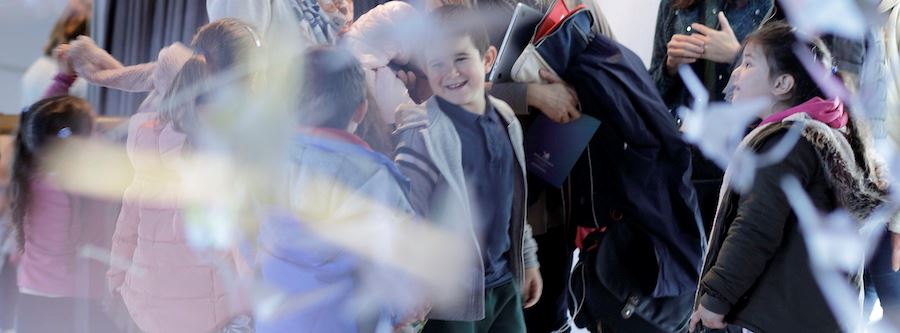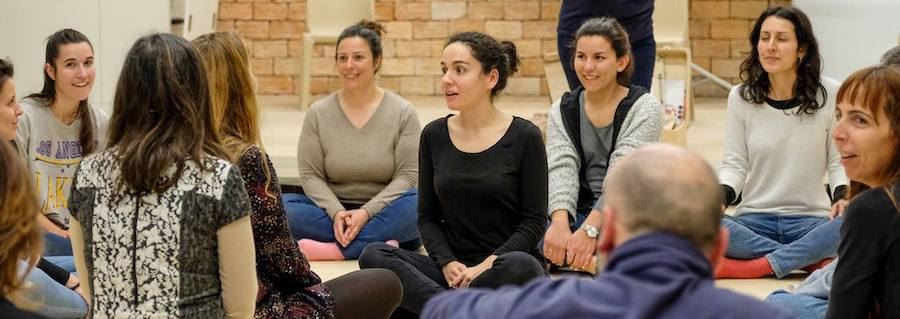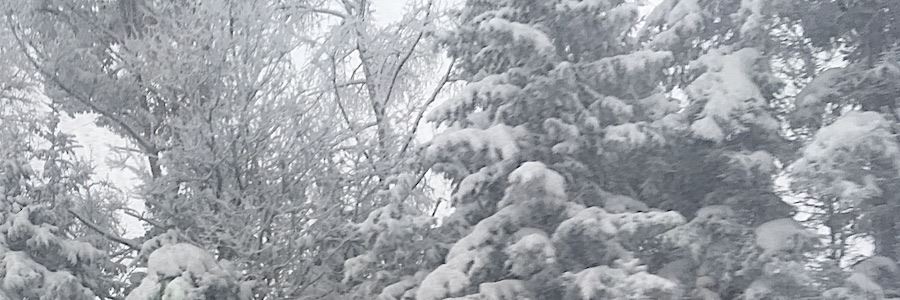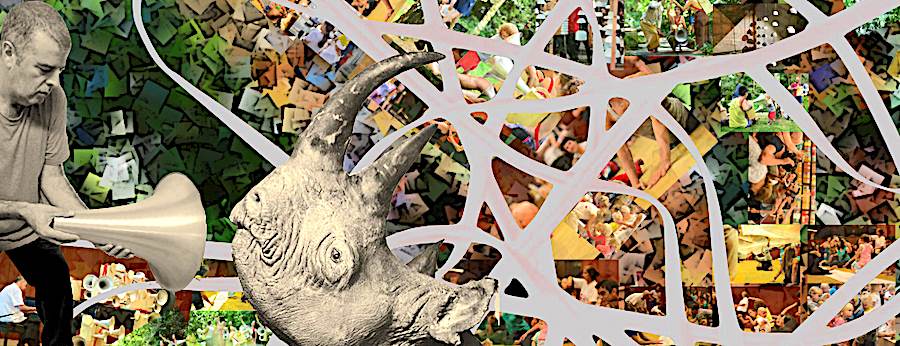
|
|

|

|
Fui ao espectáculo. Tinha passarinhos.
Duarte
Oliveira, 3 anos, após ter assistido à apresentação de PaPI-Opus 8 no
jardim de infância da Associação Gerações, V.N.Famalicão |
|
I went to the show. There were birds
Duarte Oliveira, 3 years old, after attending to PaPI-Opus 8 in Associação Gerações’s nurserie, V. N. Famalicão. |
|
 |
 |
|
| Em
Março a Primavera seguir-nos-á até Loulé. Apresentaremos a conferência
"Florir a Sul", dando sequência ao trabalho de fundo que iniciámos em
Fevereiro e que continuaremos a fazer ao longo deste ano. Estaremos nos
Açores para apresentar a conferência "Sobre pássaros que nascem na
ponta dos dedos" e a Formação "Manual para fazer nascer um bando de
pássaros”. Opus 8 voará até Paredes de Coura e os pássaros de Orizuro
chegarão à Casa das Artes de Vila Nova de Famalicão e com eles, umas
semanas depois, a instalação “Inúmera Mão”. |
|
| In
March Spring will follow us to Loulé. We will present the conference
"Florir a Sul", following the work that we started in February and that
we will continue throughout this year. We will be in the Azores to
present the conference "Sobre pássaros que nascem na ponta dos dedos"
and the training session "Manual para fazer nascer um bando de
pássaros”. Opus 8 will fly to Paredes de Coura and the birds of Orizuro
will arrive at Casa das Artes de Vila Nova de Famalicão and with them,
a few weeks later, the installation “Inúmera Mão”. |
|
 |
 |
|
| Em
Fevereiro a Constelação Orizuro brilhou em Vila Nova de Famalicão:
PaPI-Opus 8 encontrou outros pássaros em várias creches e jardins
escola do concelho. Fizémos florir os jardins sonoros de Opus 7 na
Diese em Lisboa e plantámos algumas ideias em Loulé através das
Formações Transitivas de GermInArte. Na PechaKucha Night de Aveiro
apresentámos “Um Rinoceronte em Tuttinópolis: notas autobiográficas
sobre a arte de urdir tecidos humanos e paisagens de ouvir". Estivemos
em Oslo, na Noruega. Partilhámos PaPI-Opus 8 e a nossa experiência no
domínio da educação e da arte para a infância com estudantes da Olso
Metropolitan University, com educadores e crianças. De Oslo a Loulé
voámos em bando! |
|
| In
February, the Orizuro Constellation shone in Vila Nova de Famalicão:
PaPI-Opus 8 met other birds in various nurseries and school gardens in
the country. We bloomed the sonorous gardens of Opus 7 at Diese in
Lisbon and planted some ideas in Loulé through GermInArte training
actions. At PechaKucha Night in Aveiro we presented "A Rhinocerous in
Tuttinopolis: autobiographical notes on the art of weaving human woofs
and landscapes of listening”. We went to Oslo, Norway, to share
PaPI-Opus 8 and our experience in education and art for children with
students from Olso Metropolitan University, with educators and
children. From Oslo to Loulé we flew in flocks! |
|
 |
 |
|
Sempre
me fascinou a interação musical espontânea das crianças pequenas.
Ensina-nos algumas das lições mais básicas sobre significado, poder e
comunicação na vida humana. Na infância - muito antes de se
estabelecerem as concepções limitativas das categorias musicais,
estilos e géneros- as crianças fazem uso de vocabulários musicais
lúdicos, sons e movimentos corporais como uma tecnologia do eu, como
uma maneira de comunicar com os outros e simplesmente como uma parte
necessária de ser humano no mundo.
Jan Sverre Knudsen. Professor de Música do Departamento de Educação Infantil. Oslo Metropolitan University, Noruega
|
|
I
have always been fascinated by the spontaneous musical interaction of
young children. It teaches us some of the most basic lessons about
meaning, power and communication in human life. In infancy – long
before the limiting conceptions of musical categories, styles and
genres are established, children make use of playful musical
vocabularies, sounds and body movements as a technology of the self, as
a way of communicating with others and quite simply as a necessary part
of being a human in the world.
Jan Sverre Knudsen. Professor of Music, Department of Early Childhood Education. Oslo Metropolitan University, Norway
|
|
 |
 |
|
Ao
contrário de outras cidades invisíveis, Tuttinópolis existe mesmo.
Frágil, efémera, imprevisível, bela e esquiva, tem sido construída em
vários sítios, ao longo dos últimos anos. Não tem ruas nem casas, é
feita de fios que se tecem pacientemente com sons, por vezes estranhos,
a que alguns persistem em chamar Música. Em Tuttinópolis coabitam
pessoas, pássaros e flores, porcelanas, cristais, pianos, computadores,
caixas de música e outros instrumentos super-sónicos. Em Tuttinópolis
não há muros, as pedras são usadas para fazer jardins interiores ou
então para dançar. As pessoas são muito diferentes umas das outras mas
têm a particularidade de se conseguirem entender entre si porque se
cria um “babelim” feito de sons, movimento e imagens de cada vez que os
corpos e as vozes se cruzam. Os pássaros de Tuttinópolis têm as cores
que as crianças lhes dão e cantam porque sim.
In: Um Rinoceronte em Tuttinópolis: notas sobre a arte de urdir tecidos humanos e paisagens de ouvir. |
|
Unlike
other invisible cities, Tutinopolis really exists. Fragile, ephemeral,
unpredictable, beautiful and elusive, it has been built on several
sites over the last few years. It has neither streets nor houses, it is
made of threads patiently weaved with sounds, that some persist in
designating as Music. In Tuttinópolis people, birds and flowers,
porcelains, crystals, pianos, computers, music boxes and other
super-sonic instruments cohabit. In Tuttinópolis there are no walls,
the stones are used to make inner gardens or to dance. People are very
different from each other but they have the peculiarity of being able
to understand each other because a "babelim" made of sounds, movement
and images is created each time the bodies and voices intersect. The
birds of Tuttinópolis have the colors that the children give them and
they sing because they do.
In: A Rhinocerous in Tuttinópolis: notes on the art of weaving human woofs and landscapes of listening.
|
| |
 |











